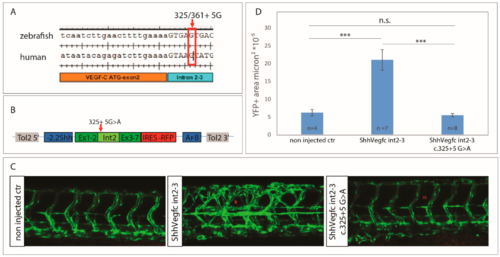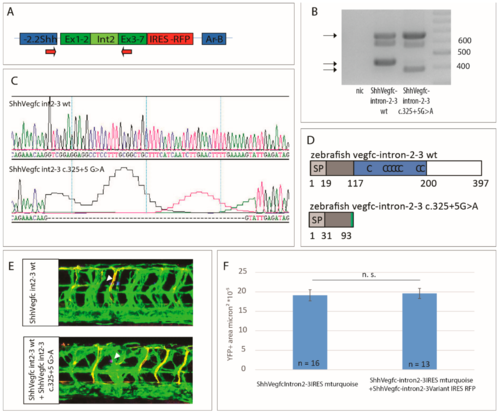FIGURE SUMMARY
- Title
-
A Novel Splice-Site Mutation in VEGFC Is Associated with Congenital Primary Lymphoedema of Gordon.
- Authors
- Nadarajah, N., Schulte, D., McConnell, V., Martin-Almedina, S., Karapouliou, C., Mortimer, P.S., Jeffery, S., Schulte-Merker, S., Gordon, K., Mansour, S., Ostergaard, P.
- Source
- Full text @ Int. J. Mol. Sci.
|
Splice site mutation c.325+5G>A in vegfc abolishes the effect of ectopic expression on excessive vessel sprouting. (A) Sequence of the human and zebrafish VEGFC/vegfc orthologs. Alignment of zebrafish and human exon 2 and intron 2–3 highlights the mutated site c.361+5G, which is equivalent to zebrafish c.325+5G. (B) Diagram of constructs used for forced expression of either vegfc-intron2–3 wt or vegfc-intron2–3 c.325+5G>A together with tagRFP in the floorplate, which consists of a 5′ and 3′ Tol2 element, the -2.2Shh promoter region, exon 1–2 of the cDNA of vegfc (Ex1–2), vegfc-intron 2–3 (Int 2) of vegfc (wt or c.325+5G>A), exon 3–7 of vegfc (Ex3–7), an IRES tagRFP cassette, and the activating region Ar-B driving expression in the floorplate. (C) Analysis of vegfc-intron2–3 wt and vegfc-intron2–3 c.325+5G>A overexpression in the floorplate using the transgenic line Tg(flt4BAC:mCitrine)hu7135 at 56 hpf. Overexpression of vegfc-intron 2–3 wt led to lymphovenous hypersprouting while forced expression of vegfc-intron2–3 c.325+5G>A had no effect on vessel growth. (D) Quantification of the YFP positive area of vessels surrounding the site of tagRFP expression showed an increased vessel density in zebrafish overexpressing vegfc-intron 2–3 wt but not in zebrafish overexpressing the vegfc-intron 2–3 c.325+5G>A variant. Values are presented as means ± standard error of mean values (SEM). *** p < 0.001, n.s. not significant.
|
|
The vegfc c.325+5G>A splice-site variant results in a truncated protein, which does not have dominant negative activity. (A) Diagram of the construct used for overexpression of vegfc-intron 2–3 depicting primers used for RT-PCR (arrows). (B) RT-PCR of zebrafish embryos expressing ShhVegfc-intron 2–3 wt or ShhVegfc-intron 2–3 c.325+5G>A. Embryos expressing the wt form of ShhVegfc-intron 2–3 and the ShhVegfc-intron 2–3 c.325+5G>A variant express a band of 660 bp corresponding to non-spliced RNA or integrated plasmid DNA as well as a second smaller band corresponding to wt ShhVegfc (440 bp) or mutant ShhVegfc (387 bp). Right lane: 100 bp ladder. Non-injected control, nic. (C) Sequencing of cDNA of embryos expressing ShhVegfc-intron 2–3 and the ShhVegfc-intron 2–3 c.325+5G>A variant showing a 53 bp deletion in the ShhVegfc-intron 2–3 c.325+5G>A variant (lower panel). (D) Schematic representation of predicted wild type (top) and mutant (bottom) proteins. Mutant protein consists of the first 91 amino acids of Vegfc containing only a part of the N-terminus of Vegfc but not the VHD or the C-terminus (see Figure 2 for legend). (E) Analysis of co-overexpression of ShhVegfc-intron 2–3 wt and ShhVegfc-intron2–3 c.325+5G>A in the floorplate using the transgenic line Tg(flt4BAC:mCitrine)hu7135 and Tg(flt1enh:tdTomato), which marks venous and lymphatic cells in green and arterial vessels in red at 48 hpf. Expression of ShhVegfc-intron 2–3 wt and ShhVegfc-intron 2–3 c.325+5G>A within the same cell are monitored by the simultaneous expression of mturquoise and tagRFP, respectively. Forced expression of ShhVegfc-intron 2–3 wt in the floorplate led to excessive vessel sprouting comparable with co-overexpression of ShhVegfc-intron 2–3 wt and ShhVegfc-intron 2–3 c.325+5G>A in the floorplate. Arrow heads mark expression of tagRFP and mturquoise in the floorplate. (F) Quantification of lymphovenous sprouting by measuring the YFP positive area surrounding the site of mturquoise/tagRFP expression. Values are presented as means ± standard error of mean values (SEM). n.s. not significant.
|
Acknowledgments
This image is the copyrighted work of the attributed author or publisher, and
ZFIN has permission only to display this image to its users.
Additional permissions should be obtained from the applicable author or publisher of the image.
Full text @ Int. J. Mol. Sci.


